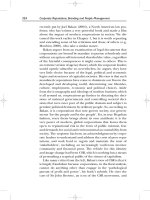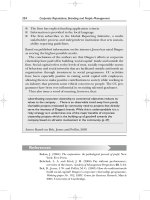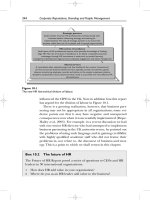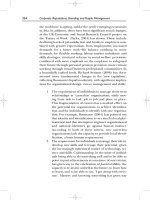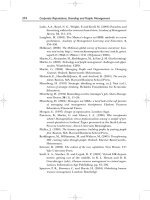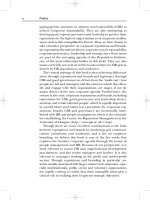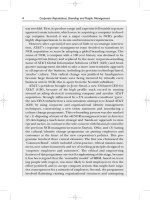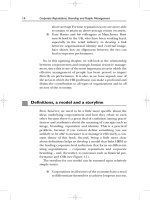Tài liệu Corporate Reputations, Branding and People Management 21 docx
Bạn đang xem bản rút gọn của tài liệu. Xem và tải ngay bản đầy đủ của tài liệu tại đây (137.06 KB, 10 trang )
numbers through the application of information and
communications technology (ICT). Low level call cen-
tre staff are one example; mid- to low-skilled HR spe-
cialists are another, given the advances of ICT in e-HR.
To help make sense of some of the material on the import-
ance of context in HRM, let’s finish off this chapter by looking
at a case of diversity management, one of the shibboleths of
politically correct, best practice HRM.
184 Corporate Reputations, Branding and People Management
Box 5.3 The Glass Ceiling: diversity management,
best practice and best fit
An Economist article in July 2005 reported an interesting conundrum.
Despite years of effort by companies to develop diversity policies, based
on best HR practice, little had changed in terms of numbers of women
in top management jobs in Fortune 500 companies (8%), with only
Employment
mode
Low High
Low
High
Human capital value
Externalized
Relational
Transactional
Core
knowledge/
creative
workers
Traditional
employees
Human capital
uniqueness
Alliance
partner
Contract
workers
Employment
relationship
Internalized
Figure 5.4
The basic architectural model.
Chapter 5 Four lenses on HR strategy and the employment relationship 185
0.7% of CEOs being female. This is despite nearly half of jobs in the US
economy being held down by women and women being as well edu-
cated as their male counterparts (as measured by Masters-level degrees)
(The Economist, 2005b). The problem is well known and quite well under-
stood, following the Wall Street Journal’s coining of the term the ‘Glass
Ceiling’ in 1985 and a US government commission on this topic in 1995.
However, it seems the success numbers are low and not getting any
bigger over time. Yet, as the report pointed out, companies are doing
more and more to address the issue with companies that were once the
bastions of male-domination, e.g. IBM, GE and BP, now making a ‘busi-
ness case’ for diversity; i.e. that diversity pays because the market is
diverse in terms of tastes, with women and racial minorities becoming
increasingly important consumers. Such increased differentiation on
the outside, so the argument goes, has to be matched by equivalent dif-
ferentiation on the inside. Moreover, given the ‘war for talent’, organi-
zations need to increase the potential pool by including as many
diverse groups as possible.
There is evidence that some North American company programmes
are beginning to work, with IBM reporting 14% of its senior executives
being women, and the Canadian company, Alcan, reporting that three
out of its four main businesses are managed by women at the top. Part
of what has been behind this has been to change the ‘tone at the top’
from long hours to more of a work–life balance culture. Yet, despite
these well publicized cases and the application of best HR practices,
the more things change, the more they remain the same in the USA
and the large European economies.
This picture, however, is not quite the same the world over. Look at
this table, which shows the proportion of female directors in different
countries in 2004.
Country Female directors as a percentage of total (approx.)
Norway 21.0
Sweden 17.0
USA 12.0
Australia 9.5
UK 7.0
(continued )
Conclusions
In this chapter we have introduced the notion of HR strategy and
four lenses on strategic HRM, all of which contribute to our
understanding of how HRM can influence reputation manage-
ment and corporate branding. We also discussed the merits of
best practice versus best fit strategic HRM. We concluded that,
since context matters a great deal in strategy, a contingency
approach to HRM is more likely to be appropriate in guiding
managers in the design of HR strategies. One of the most useful
of these contingency approaches is the architectural metaphor
developed by researchers at Cornell in the USA, which we
reworked a little to show its relevance to reputation management
and branding. The key implication of this architectural approach
and of other recent developments in HR segmentation is that
there is little sense in treating all employees the same because
they differ in their potential to add value, reputation advantage,
or risk to an organization’s key strategic drivers; they also differ in
their abilities. Different bundles of HR practices are required for
each segment, especially for those employees whose jobs help
build reputations for innovation, differentiation and entrepre-
neurship (reinforcing the initiative agenda) and those who help
exploit existing knowledge and/or maintain social legitimacy
(the cooperative agenda).
186 Corporate Reputations, Branding and People Management
Country Female directors as a percentage of total (approx.)
Germany 6.0
France 5.5
Singapore 5.0
Hong Kong 4.5
Spain 3.5
Italy 2.5
Japan 0.3
What does this table tell you about the importance of context, in this
case national context, to the application of best practices?
As the Enron case has shown, some so-called best practices
can lead to disastrous results, when pushed to the limits.
Consequently, the idea of external fit with the organization’s
environment and internal fit with each other – bundles of prac-
tices – is important in shaping employment relationships and,
therefore, reputations and brands. The above case on the Glass
Ceiling shows how embedded certain practices might be in dif-
ferent cultural and institutional settings. One of the questions
it raises is: would it ever be possible to transfer Norwegian
diversity schemes to Japan, or even Italy?
Chapter 5 Four lenses on HR strategy and the employment relationship 187
References
Barley, S. R. and Kunda, G. (2006) Contracting: a new form of
professional practice. Academy of Management Perspectives, 20,
45–66.
Becker, B. E. and Huselid, M. A. (1998) High performance work
systems and firm performance: a synthesis of research and
managerial implications, in G. Ferris (ed.), Research in personnel
and human resource management, 16, 53–101.
Boxall, P. and Purcell, J. (2000) Strategic human resource manage-
ment: where have we come from here?, International Journal of
Management Reviews, 2 (2), 183–203.
Boxall, P. and Purcell, J. (2003) Strategy and human resource manage-
ment. Basingstoke: Palgrave Macmillan.
Cascio, W. F. (2005) HRM and downsizing, in R. J. Burke and
C. L. Cooper (eds), Reinventing HRM: challenges and new direc-
tions. London: Routledge.
Economist (2005a) The conundrum of the glass ceiling, Economist,
23 July.
Economist (2005b) War games: a big payoff for two games theorists,
Economist, 15 October.
Fox, A. (1974) Beyond contract: work, trust and power relations. London:
Faber.
Guest, D. (1987) Human resource management and industrial rela-
tions, Journal of Management Studies, 24 (5), 503–521.
Huselid, M. A. (1995) The impact of human resource management
practices on turnover, productivity and corporate financial
performance, Academy of Management Journal, 38, 635–672.
Huselid, M. A., Becker, B. E. and Beatty, R. W. (2005) The workforce
scorecard: managing human capital to execute strategy. Boston,
MA: Harvard Business School Press.
Joyce, W., Nohria, N. and Robertson, B. (2003) What really works: the
4+2 formula for sustained business success. Boston, MA: Harvard
Business School Press.
Kang, S C., Morris, C. S. and Snell, S. A. (2003) Extending the human
resource architecture: relational archetypes and value creation.
CAHRS Working Paper series, 03-13. Ithaca, NY: Cornell University.
Lawler III, E. E., Mohrman, S. A. and Ledford, G. E. (1998) Organizing
for high performance: employee involvement, TQM and reengineering
programs in Fortune 1000 corporations. San Francisco: Jossey-Bass.
Legge, K. (2004) Human resource management: rhetoric and realities
(Anniversary edition). London: Palgrave.
Lepak, D. and Snell, S. A. (2002) The strategic management of human
capital: determinants and implications of different relation-
ships, Academy of Management Review, 24, 1–18.
Leseure, M. J., Bauer, J., Birdi, K., Neely, A. and Denyer, D. (2004)
Adoption of promising practices: a systematic review of the evi-
dence, International Journal of Management Reviews, 5/6, 169–190.
Mintzberg, H., Ahlstrand, B. and Lampel, J. (1998) Strategic safaris: a
guided tour through the wilds of strategic management. New York:
Free Press.
Morgan, G. (1993) Imaginization. London: Sage.
Morgan, G. (1997) Images of organization (2nd edition). London: Sage.
Paauwe, J. and Boselie, P. (2005) HRM and performance: what next?,
Human Resource Management, 15 (4), 68–84.
Patterson, M., West, M., Lawthorn, R. and Nickell, S. (1998) The impact
of people management practices on business performance. London:
Chartered Institute of Personnel and Development.
Pfeffer, J. (1998) The human equation: building profits by putting people
first. Boston, MA: Harvard Business School Press.
Pfeffer, J. (2005) Creating a performance culture. Presentation at University
of Strathclyde, 23 September.
Porter, M. (1985) Competitive advantage: creating and sustaining superior
performance. New York: Free Press.
Roberts, J. (2004) The modern firm: organizational design for performance
and growth. Oxford: Oxford University Press.
Schuler, R. and Jackson, S. (1987) Linking competitive strategies and
human resource management practices, Academy of Management
Executive, 1, 207–219.
Spector, B. (2003) HRM at Enron: the unindicted co-conspirator,
Organizational Dynamics, 32, 207–220.
188 Corporate Reputations, Branding and People Management
Stacey, R. (2001) Complex responsive processes in organization, learning
and knowledge creation. London: Routledge.
Strauss, G. (2001) HRM in the US: correcting some British impressions,
International Journal of Human Resource Management, 12, 873.
Sung, J. and Ashton, D. (2005) High performance work practices: linking
strategy and skills to work performance. London: Department of
Trade and Industry in association with the Chartered Institute
of Personnel and Development.
Sutton, R. I. (2001) Weird ideas that work: 11
1
⁄2 ways to promote, manage
and sustain innovation. London: Allen Lane, Penguin Press.
Ulrich, D. and Brockbank, W. (2005) The HR value proposition. Boston,
MA: Harvard Business School Press.
Walton, R. E. (1985) From control to commitment in the workplace,
Harvard Business Review, 85 (Jan–Feb), 77–84.
Weick, K. E. (2001) Making sense of the organization. Oxford: Blackwell.
Whittington, R. (2001) What is strategy and does it matter (2nd edition).
London: Thomson.
Wood, S. (1999) Human resource management and performance,
International Journal of Management Reviews, 1, 367–413.
Wright, P. M., Gardner, T. M. and Moynihan, L. M. (2003) The impact
of HR practices on the performance of business units, Human
Resource Management Journal, 13 (3), 21–36.
Zhang, H. and Martin, G. (2003) Human resource management practices
in Sino-foreign joint ventures. Nanhchang: Jiangxi Science and
Technology Press.
Chapter 5 Four lenses on HR strategy and the employment relationship 189
This page intentionally left blank
CHAPTER
New developments in
HR strategy and the
employment relationship
6
Introduction
In this chapter, we follow up our discussion on segmentation
to examine a range of interesting developments that should
help HR practitioners create better external and internal repu-
tations, and brands. As part of this discussion, we also introduce
the ideas underlying talent management, one of the growth
areas in strategic HR because it is one of the major problems
facing businesses and public sector organizations, especially in
the knowledge sectors and creative industries. We also evaluate
these ideas using the lenses introduced in Chapter 5 to reveal
their strengths and weaknesses. Finally, we discuss some of the
international issues of reputation management, branding and
HR, concluding with a case of Wal-Mart in Germany. For those
readers involved in multinational companies, we develop these
international issues in Chapter 7.
To give readers an insight into the problems certain organ-
izations are facing in this field, we will use a consulting case we
were asked to work on. Confidentiality is important here so we
have changed the name and location of the company to
protect its identity.
192 Corporate Reputations, Branding and People Management
Box 6.1 Business and HR issues at Banco (South)
The strategic drivers
Banco (South) (the Company), part of the Banco Group, has under-
gone a great deal of change over the past decade, including a recent
strategic re-positioning and re-branding exercise that has attempted to
differentiate the bank from competitors as a ‘local’, regional bank but
with access to all of the advantages and resources of a major, ‘global’
financial institution. This positioning and re-branding exercise has
been accompanied by the development of a group-wide internal values
and behaviours framework, drawing on ideas, research and material
from head office. Banco (South) takes part in a group-wide engage-
ment survey carried out by a major survey consulting organization.
This survey provides a temperature check in the form of quarterly
results on employee identification (including internalization of group
values, feedback on management style and career development) and
engagement with the Group values, as demonstrated by engagement
behaviours. The results of this survey are used to provide feedback to
senior managers on how people management is supporting the key
business drivers, including sales performance and revenue generation,
and is used to calculate the performance bonuses of managers in the
region.
The Company benchmarks itself against Group norms on all per-
formance indicators, and against performance norms for the financial
services industry as a whole. As part of this exercise, it uses consulting
data to benchmark against engagement norms for the industry, shown
it to be in the top quartile for all companies in the relevant group.
However, the Company norms on certain key indicators, particularly
engagement, are lower than the Group mean norms, even though the
South region performs well overall in revenue generation. A further
issue raised during discussions with HR staff was the South region’s
needs to put into place a fresh initiative for IIP re-accreditation
(Investors in People
1
), due in 2006.
1
Investors in People (IIP) accreditation is a quality standards exercise for HR that
many UK companies seek to use as a means of guaranteeing the quality of their
HR provision. Gaining and retaining accreditation is an exacting process used in
setting performance objectives for HR departments and as part of an employer of
choice policy.
Chapter 6 HR strategy and the employment relationship 193
Initial diagnosis
In discussions with senior HR staff, the following problems were iden-
tified as potential causes or factors underlying the Company’s per-
formance problems:
1 There was perceived to be no clear line of sight between employees’
understanding of the values and behaviours framework and the
external image and positioning of the organization. It was felt that
this might be a consequence of using a ‘global’ values framework cre-
ated by Head Office, which might have had less resonance with the
‘local’ situation of employees of the Company in the South region.
2 Although there were various sophisticated HR initiatives in place,
there was a perception of lack of coherence among them and that
they might not be addressing the key strategic drivers of the new
strategy and brand. It was felt that there was a morale problem
among substantial elements of the Company workforce who were
either actively disengaged or apathetic. Without fully understand-
ing the reasons for this, there was a suspicion that leadership and
management style, and the basis of rewarding managers for short-
term sales performance may be part of the problem. Though lead-
ership style and the basis for rewarding managers may have been
linked, this was not always clear and could vary over the regional
network; in any event, changing rewards policy was a Group func-
tion and not something that could be altered locally by Company
HR staff.
3 Whilst the new survey dealt with general levels of engagement and
employees’ understanding of the values, it was not sensitive enough
to provide the information to allow Company HR staff to develop
‘locally sensitive’ HR policies that would help drive the positioning
and branding strategy and improve the benchmarking perform-
ance. This applied to Banco (South) and its 10 districts, which form
the South region retail banking network. It also applied to its whole-
sale banking, private banking and regional head office services
(including HR, marketing, finance and IT).
4 Senior HR staff also believed that delivery on psychological con-
tracts by the Company of what employees want, value and expect
may be part of the problem: they may be over-delivering in key areas
on the needs of certain groups of employees and under-delivering
to others, with the knock-on consequences for attraction, retention,
